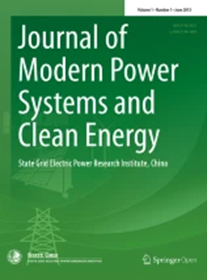High-Dimensional Steady-State Security Region Boundary Approximation in Power Systems Using Feature Non-Linear Converter and Improved Oblique Decision Tree
IF 5.7
1区 工程技术
Q1 ENGINEERING, ELECTRICAL & ELECTRONIC
Journal of Modern Power Systems and Clean Energy
Pub Date : 2024-08-01
DOI:10.35833/MPCE.2024.000188
引用次数: 0
Abstract
The steady-state security region (SSR) offers robust support for the security assessment and control of new power systems with high uncertainty and fluctuation. However, accurately solving the steady-state security region boundary (SS-RB), which is high-dimensional, non-convex, and non-linear, presents a significant challenge. To address this problem, this paper proposes a method for approximating the SSRB in power systems using the feature non-linear converter and improved oblique decision tree. First, to better characterize the SSRB, boundary samples are generated using the proposed sampling method. These samples are distributed within a limited distance near the SSRB. Then, to handle the high-dimensionality, non-convexity and non-linearity of the SSRB, boundary samples are converted from the original power injection space to a new feature space using the designed feature non-linear converter. Consequently, in this feature space, boundary samples are linearly separated using the proposed information gain rate based weighted oblique decision tree. Finally, the effectiveness and generality of the proposed sampling method are verified on the WECC 3-machine 9-bus system and IEEE 118-bus system.基于特征非线性变换器和改进斜决策树的电力系统高维稳态安全区域边界逼近
稳态安全区域为具有高不确定性和波动性的新型电力系统的安全评估和控制提供了强有力的支持。然而,准确求解高维、非凸、非线性的稳态安全区域边界(SS-RB)是一个重大挑战。为了解决这一问题,本文提出了一种利用特征非线性变换器和改进斜决策树来逼近电力系统中SSRB的方法。首先,为了更好地表征SSRB,使用所提出的采样方法生成边界样本。这些样本分布在SSRB附近的有限距离内。然后,利用设计的特征非线性转换器将边界样本从原始功率注入空间转换为新的特征空间,以处理SSRB的高维性、非凸性和非线性问题。因此,在该特征空间中,使用所提出的基于信息增益率的加权斜决策树对边界样本进行线性分离。最后,在WECC 3机9总线系统和IEEE 118总线系统上验证了所提采样方法的有效性和通用性。
本文章由计算机程序翻译,如有差异,请以英文原文为准。
求助全文
约1分钟内获得全文
求助全文
来源期刊

Journal of Modern Power Systems and Clean Energy
ENGINEERING, ELECTRICAL & ELECTRONIC-
CiteScore
12.30
自引率
14.30%
发文量
97
审稿时长
13 weeks
期刊介绍:
Journal of Modern Power Systems and Clean Energy (MPCE), commencing from June, 2013, is a newly established, peer-reviewed and quarterly published journal in English. It is the first international power engineering journal originated in mainland China. MPCE publishes original papers, short letters and review articles in the field of modern power systems with focus on smart grid technology and renewable energy integration, etc.
 求助内容:
求助内容: 应助结果提醒方式:
应助结果提醒方式:


